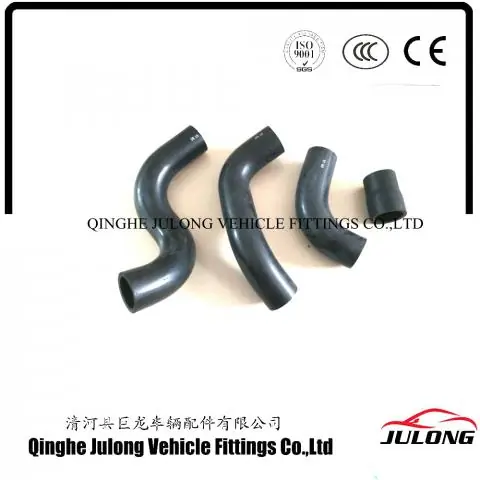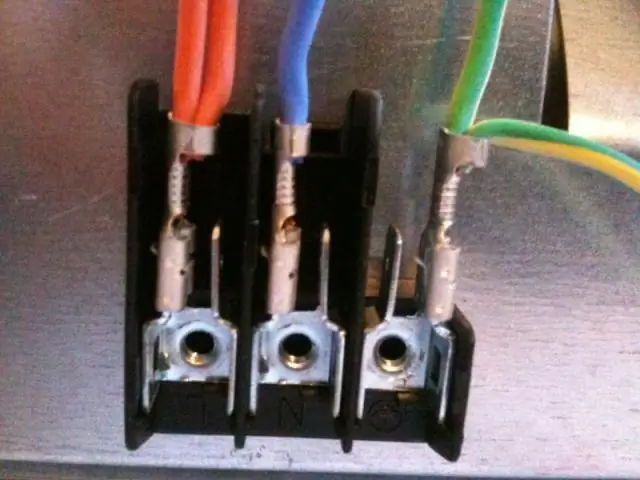
Table of contents:
- Author Bailey Albertson [email protected].
- Public 2023-12-17 12:53.
- Last modified 2025-01-23 12:41.
Purpose, malfunctions and replacement of the radiator of the VAZ 2104-2107 stove

No matter how reliable the car is, sooner or later a breakdown of one or another part occurs. Owners of VAZ 2104-2107 sometimes have to deal with the problem of poor heating of the passenger compartment or with a leak in the stove radiator. In this case, you need to deal with the reasons, repair or replace the product.
Content
-
1 What is a car heater radiator
- 1.1 Where is the stove radiator installed on the VAZ 2104-2107 and what functions does it perform
- 1.2 The device of the heater radiator
- 2 Radiator malfunctions, their symptoms and causes
-
3 How to replace and repair a radiator for a VAZ 2104-2107 stove
- 3.1 What tools are needed
-
3.2 How to remove the stove radiator
3.2.1 Video: replacing a heat exchanger using the example of a VAZ 2107
-
3.3 How to fix a stove radiator leak
- 3.3.1 Video: soldering the stove radiator
- 3.3.2 Flushing the radiator
- 3.4 How to install the heat exchanger
-
3.5 Radiator selection
3.5.1 Video: which radiator to choose on the "Zhiguli"
What is a car stove radiator
Almost every car is equipped with an interior heating system, in which one of the main elements is a radiator. Thanks to this part, heat is removed from the coolant and then supplied to the passenger compartment.
Where is the stove radiator installed on the VAZ 2104-2107 and what functions does it perform
The stove radiator on all classic Zhiguli is located in a special box under the front panel. The product is a heat exchanger, the main function of which is to transfer heat from the coolant (antifreeze) with subsequent distribution throughout the cabin. This assembly works in the same way as the main radiator of the power unit. In order for the stove to function correctly, constant heating of the heat exchanger is necessary. It is provided by connecting the radiator to the engine cooling system using pipes and rubber pipes and constant fluid circulation through a water pump (pump).

The heater radiator on the "classic" is located in a special box under the front panel
Stove radiator device
The heat exchanger consists of two tanks and copper or aluminum honeycomb. The tanks are connected by soldering or sealant, depending on the material of manufacture of the part. In addition to the radiator, the main units of the stove are the fan and the control unit, which consists of levers and cables.

1 - additional resistor of motor speeds; 2 - fan casing; 3 - fan guide casing; 4 - spring holders of the lower case; 5 - radiator housing; 6 - air intake cover; 7 - radiator gasket; 8 - stove radiator; 9 - coolant pipes; 10 - stove tap; 11 - impeller of the heater electric motor; 12 - heater electric motor; 13 - spring latch of the stove motor; 14 - stove motor pillow; 15 - damper of the side air ducts; 16 - bottom cover (damper) of the stove, blowing off the legs
Air from the outside flows through an opening in the bonnet and enters the plastic air inlet casing located in the engine compartment under the windshield. Then the air flow enters the heat exchanger, which is heated by the coolant (coolant). When the car is idle or driving at low speed in the cabin, the stove fan is turned on, which drives cold air through the radiator, thereby heating it and supplying it to the cabin.

The stove radiator consists of tanks and honeycombs through which coolant circulates
When the car is moving at high speed, the fan may not be turned on, since sufficient pressure is created from the oncoming flow to pump warm air. The more the coolant heats up, the more heat the radiator gives off. The level of the liquid entering the heat exchanger is regulated by means of a valve. Therefore, if there is a need to change the temperature in the cabin, for example, to make the air less hot, the tap is closed partially or completely by means of a flexible rod and a lever.
The stove control is pretty simple. There are several handles on the center panel:
- the upper one is designed to adjust the position of the stove valve (to the left - the valve is closed, to the right - open);
- the middle knob changes the position of the air inlet cover, thereby changing the intensity of the warm air supply;
-
the lower lever provides adjustment of the glass heating air duct flap (position to the right - the air flow goes to the side windows, to the left - to the wind flow).

Stove control in the VAZ 2107 cabin The stove in the cabin is controlled using three levers that can be moved horizontally
Radiator malfunctions, their symptoms and causes
During the operation of VAZ 2104, 2105, 2107 cars with a stove radiator, malfunctions may occur that require repair work. As a rule, all problems come down to the fact that the efficiency of heating the passenger compartment is reduced. Let's consider the most probable reasons for this phenomenon.
- Air lock in the cooling system. Such a malfunction can occur as a result of replacing engine components related to the cooling system or antifreeze, as a result of which the stove heats up weakly, or does not give off heat at all. To restore the heater to work, you need to let the motor run at high speeds in order to expel air from the system.
- When the stove tap is open, the line remains closed. The reason is clogging of the locking mechanism or the formation of limescale if water is used instead of antifreeze. The problem is solved by cleaning or replacing the faucet.
- The radiator stays cold when the tap is fully open. The problem may be caused by a problem with the water pump. The malfunction is difficult not to notice, since the engine quickly overheats, as evidenced by the pointer on the instrument panel. If the engine is warmed up to operating temperature (+90 ˚ C), and the supply pipe of the stove remains cold, the alternator belt may break or a blockage in the supply pipe from the pump.
-
The inlet is hot and the air from the stove is cold. Such a problem is quite common in classic Zhiguli models. The reason is the clogged radiator cells, which is due to the use of water instead of antifreeze or the use of additives to eliminate leaks. In this case, the radiator must be dismantled and washed.

Stove radiator clogging The stove may not heat well due to the blockage of the honeycomb, both outside and inside.
- The inlet and outlet are hot and the air is cold. This problem is observed as a result of the displacement of the baffle in the heat exchanger, which leads to the circulation of coolant directly between the pipes, bypassing the radiator itself. In this case, the assembly needs to be replaced.
Problems with the heat exchanger can manifest itself not only in the form of supplying cold air instead of hot air, but also the appearance of a leak. The problem can be detected by the formation of a puddle on the floor, as well as by the appearance of an oily coating on the side and windshield during the operation of the stove. The reasons may be:
- coolant leak through the stove faucet;
- leak from the pipe;
- leakage of the radiator itself.
In the first two cases, replacement of the worn out element is required, and if a leak from the radiator appears, the part needs to be repaired or replaced.
If antifreeze is used in the cooling system, and not water, the coolant leak must be eliminated as soon as possible, since the fluid contains substances harmful to human health
How to replace and repair a radiator for a VAZ 2104-2107 stove
If your Zhiguli has problems with the heater radiator, you need to know how and in what sequence to make repairs.
What tools will be needed
First of all, you need to prepare the necessary tools and materials:
- Phillips screwdriver
- keys set;
- sealant;
- container for draining coolant;
- new heat exchanger;
-
clean rags.

Stove radiator repair tools To replace the radiator of the stove, you will need a Phillips screwdriver, keys, sealant, clean rags and a container for draining the coolant
How to remove a stove radiator
Work on replacing the radiator on carburetor and injection engines is carried out in the same way. First of all, you need to drain the coolant from the cooling system, for which you unscrew the plug on the engine block and drain the antifreeze into a suitable container. After that, you can proceed to dismantle the unit.
-
We loosen the clamps for fastening the inlet and outlet pipes of the radiator of the stove in the engine compartment and tighten the hoses.

Removing the pipes Having unscrewed the clamps, we pull off the hoses from the radiator pipes
-
Having moved to the salon, we unscrew the fastening of the shelf located under the glove compartment.

Dismantling the shelf To remove the shelf located under the glove compartment, unscrew the two screws on the right and one on the left
-
When the shelf is removed, access to the stove tap opens. Using a 7 mm wrench, unscrew the cable mount and move the flexible element to the side.

Fastening the cable Using a 7 mm wrench, unscrew the fasteners for the heater tap control cable
-
To get to the radiator, remove the stove casing latches by prying them off with a screwdriver and thereby removing the lower part of the box.

Box latches To remove the lower part of the heater, you will need to pry 4 latches with a screwdriver
-
We take out the heat exchanger together with the tap.

Stove radiator To remove the radiator, just pull it towards you
- We unscrew the fastening of the locking mechanism and replace the radiator or repair it.
-
Unscrew 2 bolts from the tap, disconnecting it from the tube, inspect the sealing elements, check the mechanism itself.

Supply tube Disconnect the tube from the old tap and remove the sealing rubber
Video: replacing a heat exchanger using the example of a VAZ 2107
How to fix a stove radiator leak
If the heater radiator of a VAZ 2107 or other classic model "Zhiguli" has flowed, then the problem can be eliminated in several ways:
- replace the part with a new one;
- apply special additives;
- repair the old heat exchanger.
If in the first case no problems should arise, then the additives should be treated more carefully. This is due to the fact that such funds can not only eliminate the leak, but also clog the radiator cells. Therefore, it is preferable to repair the part. If you have experience with a soldering iron, then by soldering you can try to repair the problem area (only on a copper radiator).
To work, you will need the following tools and materials:
- solder and flux;
- sandpaper;
- powerful soldering iron (150-200 W);
- degreaser;
-
rags.

Solder and acid To solder the radiator, you will need solder and flux or soldering acid
After dismantling the radiator, the leak location can be detected by a colored spot in accordance with the color of the antifreeze. The essence of the repair comes down to the following steps:
- cleaning the leak with sandpaper;
- degreasing;
- soldering with a soldering iron.
Brazing can also be done with a gas torch. After repair, it is recommended to wash the radiator and check for leaks.
Video: soldering the stove radiator
Radiator flushing
For flushing, the radiator is connected to a water tap using a hose, after which the water is run until it becomes clean. To check the tightness of the radiator, you can use a manual tire pump or a compressor, while one outlet of the heat exchanger is closed with a finger or a plug, and air is pumped through the other. The part itself must be immersed in a bucket of water. If there are no air bubbles, then the repair was successful. Otherwise, the soldering is repeated or the part is simply replaced with a new one.

To check the tightness of the radiator, air is supplied to it from a compressor or a hand pump
Some car owners use cold welding or sealant to fix leaks. These substances are applied to a previously cleaned and degreased surface in accordance with the instructions. Which method and means to give preference depends only on your personal preference.
How to install a heat exchanger
In order to avoid leaks when installing the radiator, it is recommended to use new seals and pipes. Installation is carried out in the following order.
-
Install a gasket and fix the inlet tube to the tap and the outlet to the radiator.

New seal It is recommended to use new seals when installing the radiator
-
The locking mechanism is attached to the heat exchanger.

Crane fixing A tap is installed on a new radiator together with a tube
- Mount the radiator in place.
-
They fix the crane control cable, not forgetting to make adjustments to fully open and close the latter.

Adjusting the cable In order for the valve to open and close completely, it is necessary to adjust the cable
-
A sealant is applied to the radiator tubes, pipes are put on and fixed with clamps.

Sealant-gasket To improve the tightness, a little sealant is applied to the supply pipe before docking with the branch pipe.
-
Pour coolant, while checking that the stove valve is open.

Radiator filler After repairing or replacing the radiator of the stove, they fill the system with coolant
- Check the heating system for leaks.
When the assembly process is completed, you need to start the engine and let it run until the coolant temperature reaches operating temperature. After that, it is necessary to check all connections for leaks. The antifreeze level is checked on the expansion tank and, if required, top up.
Radiator selection
If it was revealed that the stove radiator needs to be replaced, you need to decide how to choose a new part. Today in the automotive market there is a wide selection of heat exchangers, so choosing the best option is sometimes not easy. The part can be purchased both for 500 rubles and for 3 thousand rubles. However, you can choose a product of good quality and at a reasonable price. Preference should be given to such manufacturers:
- AvtoVAZ, Pekar, Luzar, SHAAZ;
-
Oberkraft, Finord, Extra.

Copper radiator "Luzar" for VAZ 2104-2107 The copper radiator of the stove is characterized by better heat transfer and maintainability.
When buying a new radiator, attention should be paid to the following:
- a quality product cannot be cheap;
- a certificate should be required from the seller to reduce the likelihood of acquiring a fake;
- a good heat exchanger should have honeycombs close to each other.
In addition to the above, it should be taken into account that the part can be made of aluminum or copper. Copper radiators have undeniable advantages, which are due to high heat transfer and ease of repair. However, due to their high cost, they are used less and less. Aluminum have an affordable cost, less weight, but in the event of a leak, restoring the part will be quite problematic. Therefore, as a rule, aluminum products must be replaced.

An aluminum radiator is cheaper than a copper radiator, but if a leak appears, it will have to be replaced
Video: which radiator to choose for "Zhiguli"
It is not as difficult to diagnose problems with the radiator of the stove on the Zhiguli as it might seem at first glance. If there are problems with the heat exchanger, then you do not have to contact the service to fix them: you can do the work yourself, having previously read the step-by-step instructions.
Recommended:
Do-it-yourself Sauna Stove (brick And Metal): Installation, Drawings, Step-by-step Instructions, Etc. + Video

Classification and features of sauna stoves. The choice of the optimal design and options for making do-it-yourself sauna stoves. Diagrams and step-by-step instructions
Do-it-yourself Wood Stove - How To Make Economical Wood-fired Stove Heating, Device, Diagram, Drawing, Design With A Water Circuit, Reactive, Iron, Metal, For A Greenhouse + Video

Features and types of wood-burning stoves. Sizing and finding a place to install the oven. Do-it-yourself wood stove installation. Operating a wood-fired oven
Do-it-yourself Potbelly Stove - How To Do It, Instructions With Photos And Diagrams + Video

The design of a potbelly stove for mining, its principle of operation, recommendations for DIY assembly and operation
How To Remove Iodine From Clothes And Other Surfaces, Than To Wash It From The Skin, Various Methods And Means + Video And Photo

How to remove iodine from different fabrics, wash stains from furniture, body and other surfaces. Effective ways with instructions for use with photos and videos
How To Remove Scratches From The Screen Of Technology: How To Remove Them Yourself, Reviews, Video

Damage to gadget screens and how to fix them. Improvised and special means, reviews. Preventing scratches on screens and plastic parts
